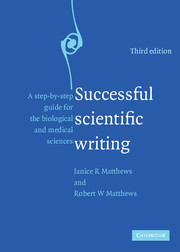Book contents
- Frontmatter
- Contents
- Preface
- Preface to the third edition
- 1 PREPARING TO WRITE
- 2 COMPOSING A FIRST DRAFT
- 3 VISUAL SUPPORT FOR THE WRITTEN WORD
- 4 VISUAL SUPPORT FOR THE SPOKEN WORD
- 5 REVISING TO INCREASE COHERENCE
- 6 IMPROVING WORD CHOICE, AND SYNTAX STYLE
- 7 ATTENDING TO GRAMMAR, NUMBERS, AND OTHER MECHANICS
- 8 THE REST OF THE STORY
- Appendix 1 Suggested responses to exercises
- Appendix 2 Excerpts from “Uniform requirements for manuscripts submitted to biomedical journals: Writing and editing for biomedical publication”
- Selected resources
- Index
6 - IMPROVING WORD CHOICE, AND SYNTAX STYLE
- Frontmatter
- Contents
- Preface
- Preface to the third edition
- 1 PREPARING TO WRITE
- 2 COMPOSING A FIRST DRAFT
- 3 VISUAL SUPPORT FOR THE WRITTEN WORD
- 4 VISUAL SUPPORT FOR THE SPOKEN WORD
- 5 REVISING TO INCREASE COHERENCE
- 6 IMPROVING WORD CHOICE, AND SYNTAX STYLE
- 7 ATTENDING TO GRAMMAR, NUMBERS, AND OTHER MECHANICS
- 8 THE REST OF THE STORY
- Appendix 1 Suggested responses to exercises
- Appendix 2 Excerpts from “Uniform requirements for manuscripts submitted to biomedical journals: Writing and editing for biomedical publication”
- Selected resources
- Index
Summary
On the whole, I think the pain which my father took over the literary part of the work was very remarkable. He often laughed or grumbled at himself for the difficulty which he found in writing English, saying, for instance, that if a bad arrangement of a sentence was possible, he would be sure to adopt it … When a sentence got hopelessly involved, he would ask himself “now what do you want to say?” and his answer written down, would often disentangle the confusion.
– Charles Darwin's son, Francis (Darwin, 1897)Like Charles Darwin, most of us need to go over our writing to disentangle confusion, particularly in word choice, syntax, and style. Syntax refers to the relationships between the words and other elements in a sentence. Style means the way something is done, or its basic “personality.” Thus we speak of a scientific writing style characterized by clarity and organization, an editorial style that presents written material in a certain way, or a typographic style with various artistic elements.
The importance of these three aspects of scientific writing springs from the precision which science requires. More than one interpretation of a sentence or phrase is unacceptable, so careful attention must be paid to both word choice and word arrangement.
This step may have been what you have been expecting – and dreading – from the start. Admittedly, it can be hard work, but stick with us.
- Type
- Chapter
- Information
- Successful Scientific WritingA Step-by-Step Guide for the Biological and Medical Sciences, pp. 125 - 152Publisher: Cambridge University PressPrint publication year: 2007



